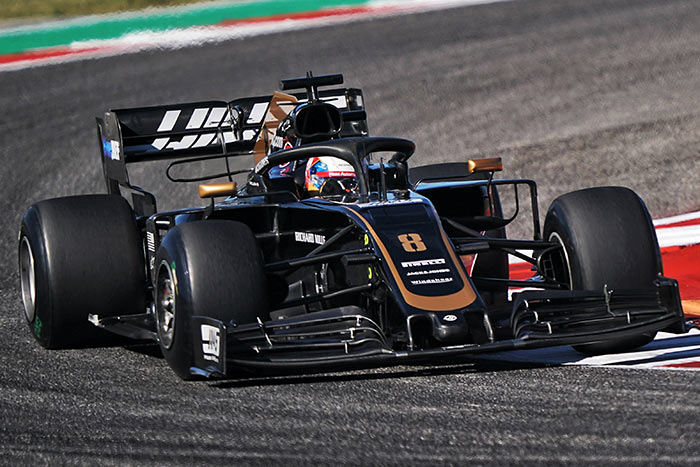Haas VF-19 Ferrari

Active: 2019
Team: Haas F1 Team
Team: Phil Dixon (HVP), Ayao Komatsu (CRE), Steve Fraser (HEL), Fabio Segalini (DCD), Matthew Scott (CM), Gene Haas (Chairman), Peter J. Crolla (TM), Gunther Steiner (TP)
Drivers Romain Grosjean (8), Kevin Magnussen (20), Pietro Fittipaldi (test)
Team name: Rich Energy Haas F1 Team
Major partners: Haas Automation, Jack & Jones, Peak, BlueDEF, Richard Mille, Alpinestars
Rich Energy Haas F1 Team unveiled its new-look for the 2019 FIA Formula One World Championship with a livery launch hosted at the Royal Automobile Club (RAC) on Pall Mall in London, while the design of its VF-19 challenger debuted online across the team's website and social media platforms.
Incorporating the resplendent black and gold colors of Rich Energy, the premium British energy drink first announced as title partner of Haas F1 Team in October 2018, the 2019 livery was revealed on a show car in London as drivers Romain Grosjean and Kevin Magnussen, together with team principal Guenther Steiner and Rich Energy chief executive officer William Storey, peeled back the covers before a throng of assembled guests at the RAC.
Though the new livery looked distinctive, the actual sponsorship deal soon crumbled away, and the team later revealed that it had only received an initial payment from Rich Energy. No further agreed payments were honoured, making the team end its partnership on 9 September. The car completed the remaining 7 races of the season in the same livery, but without the Rich Energy label or logo.
Team principal Guenther Steiner said at the presentation: "It's important that we keep progressing as a team, and this season is no different. Our partnership with Rich Energy is another positive example of moving forward as an organization. We're pleased to see their colors on the VF-19, we welcome them as they join our valued partner group in utilizing Formula One as a global marketing platform. While 2018 delivered our best season to-date, the year showed, sometimes sharply, that we still have areas to improve on as a team. On-track, our push for performance started early with the VF-19, our next step is to get to Spain and utilize our time there wisely to prepare for Australia."
The car's differences compared to its 2018 predecesser were mainly driven by the changed regulations. The simplified front-wing is evident, now 200mm wider and 20mm higher - designed to allow drivers to follow each other more closely and increase the possibility of overtaking. Similarly, the rear wing has been made simpler, as well as 20mm higher and 100mm wider, to aid slipstreaming and promote closer racing. Smaller, repositioned barge boards are also visible, reduced in height by 150mm and moved forward by 100mm, these have been designed to improve air flow from the front wing making them less aerodynamically disruptive.
Performance
On the race track, the car made a solid start to the season, with Magnussen immediately scoring a 6th place finished at the Australian Grand Prix. This would however be the team's best result of the season, as afterwards the team struggled to develop its car. Despite showing solid qualifying pace at times, both drivers struggled to keep up in the race while continuing their reputation of "risky pilots" with unneeded accidents.
The struggles were so bad that the team decided to revert Romain Grosjean's car to the Australian GP specification at the British Grand Prix. The experiment lasted for several more races, proving the team had made little or no progress at all in the first half of the season. It didn't matter much, because the team's second half of the season was worse than the first. After the Hungarian Grand Prix, midway in the season, only 2 points were scored, resulting in a 9th place finish in the Constructors' Championship, the team's worst since it joined Formula One in 2016.
Specifications
Chassis: Carbon-fibre monocoque
Front suspension: Upper and lower wishbones, inboard springs and dampers actuated by push-rods
Rear suspension: Upper and lower wishbones, inboard springs and dampers actuated by pull-rods
Dampers: ZF Sachs Race Engineering
Brakes: Six-piston callipers and carbon fibre pads and discs
Transmission: Ferrari 8-speed quick-shift sequential carbon-cased gearbox, hydraulically activated. Longitudinally mounted
Clutch: Carbon fibre plates, by AP Racing
Differential: Servo controlled hydraulic limited-slip differential
Electronics: FIA standard ECU and FIA homologated electronic and electrical system (as provided by MES)
Steering: Ferrari
Tyres: Pirelli
Wheels: OZ, magnesium alloy
Dimensions
Height: 950 mm (minus T camera)
Track width: 1,600 mm (front); 1,550 mm (rear)
Weight: 743kg (FIA mininum; incl. driver and lubricants, tank empty)
Powertrain
Designation: Ferrari 064
Type: turbocharged, 90° 1.6l V6, assisted with kinetic and heat ERS
Valves: 24 (4 per cylinder)
Rev limit: 15,000rpm
Pressure charging: Single turbocharger, unlimited boost pressure (typical maximum 3.5 bar abs due to fuel flow limit)
Bore: 80mm
Stroke: 53mm
Crank height: 90mm
Exhaust: Single exhaust outlet, from turbine on car centre line, along with two outlet pipes connected to the wastegate
Injection: Direct fuel injection, limited to 500bar
Weight: Undisclosed (at least 145kg)
Total horsepower: More than 900hp
Energy recovery system: Integrated Hybrid energy recovery via electrical Motor Generator Units
Energy Store: Lithium-Ion battery solution (up to 4MJ per lap), between 20 and 25 kg
Cooling system: Secan/Marston
Fuel and lubricants: Shell




